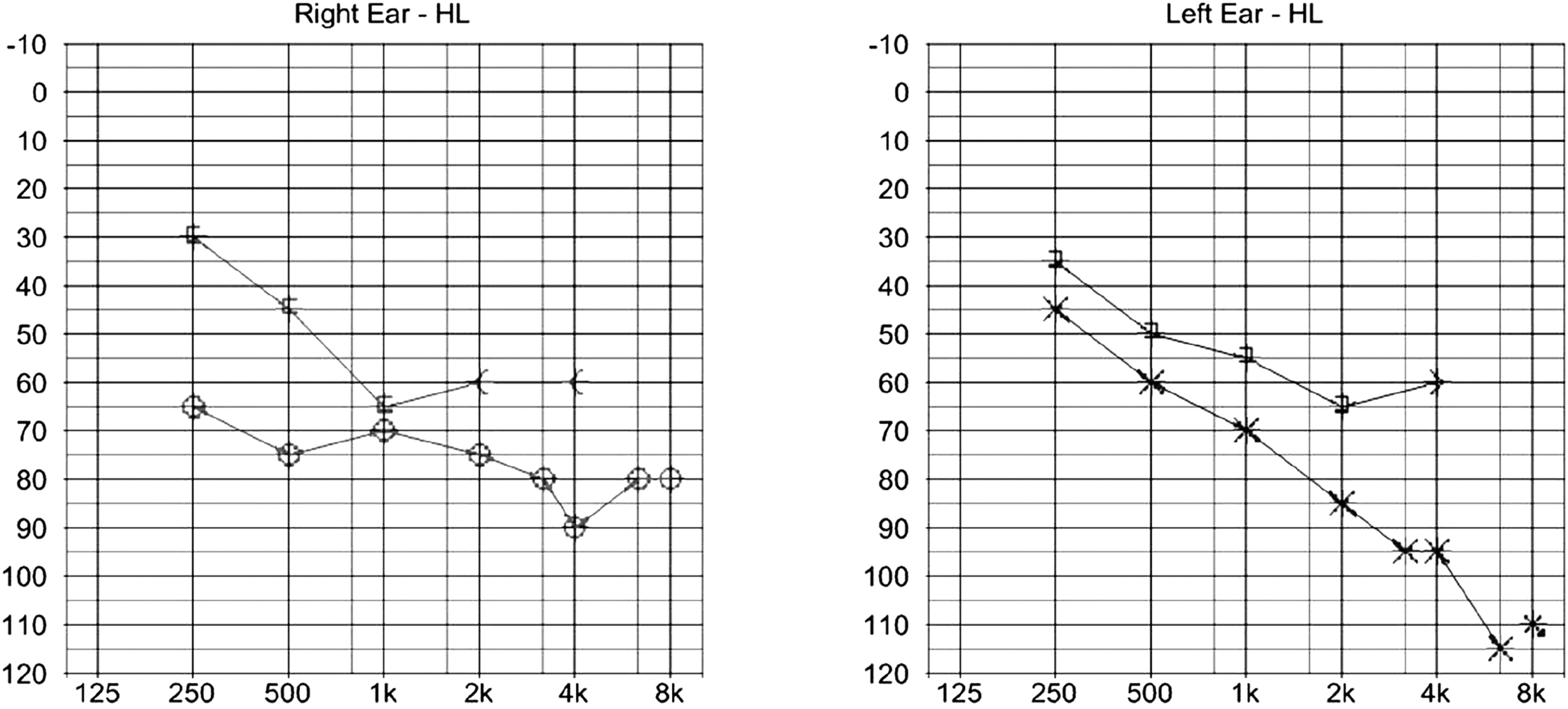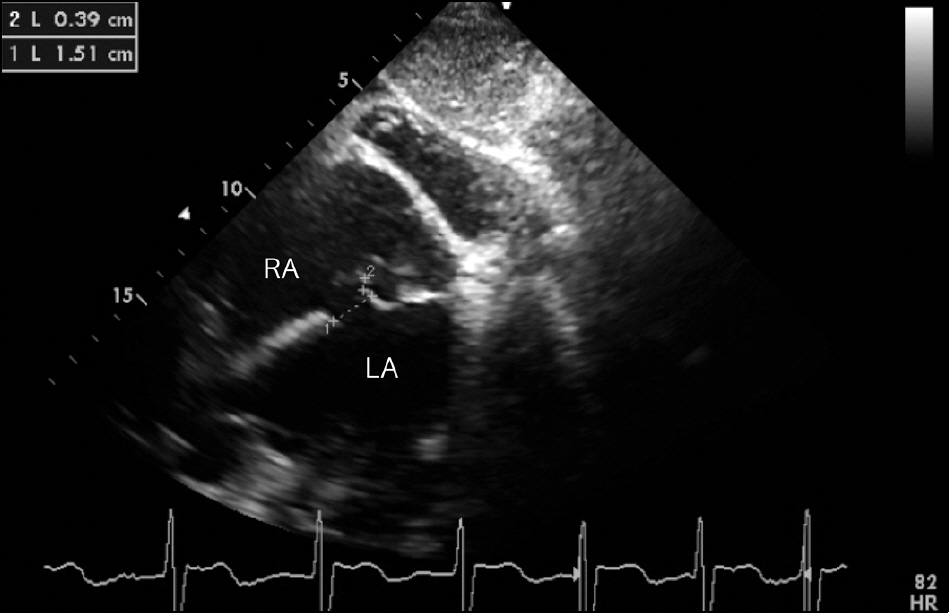J Korean Ophthalmol Soc.
2013 Jul;54(7):1119-1125. 10.3341/jkos.2013.54.7.1119.
A Case of Congenital Rubella Syndrome
- Affiliations
-
- 1Department of Ophthalmology, Jeju National University School of Medicine, Jeju, Korea. amario@naver.com
- KMID: 2217426
- DOI: http://doi.org/10.3341/jkos.2013.54.7.1119
Abstract
- PURPOSE
We report a case of congenital rubella syndrome with bilateral zonular cataracts.
CASE SUMMARY
A 69-year-old man visited the hospital with visual disturbance in both eyes. His mother had been diagnosed with rubella during pregnancy, exhibiting typical fever and rashes. His visual acuity and hearing ability had been poor since birth. Corrected visual acuity was 0.3 in the right eye and 0.4 in the left eye. Slit lamp examination revealed bilateral zonular cataracts. On pure tone audiometry test, pure tone hearing threshold was 73 dB in the right ear and 72 dB in the left ear, corresponding to severe hearing loss in both ears. Echocardiogram showed a 1.5 cm-sized ostium secundum atrial septal defect, causing atrial fibrillation. Laboratory workup revealed an extremely high level of IgG antibody (titer = 1:301), and negative IgM antibody. A rubella IgG avidity test was 95.5%, suggesting remote rubella infection. Chromosomal analysis from peripheral blood did not show any abnormalities. The patient was diagnosed with congenital rubella syndrome with bilateral zonular cataracts. Two months after cataract surgery on both eyes, visual acuity steadily improved to 1.0 in both eyes.
CONCLUSIONS
Congenital rubella syndrome is comprised of physical abnormalities such as sensorineural hearing loss, eye defects including congenital cataract, and cardiovascular defects due to gestational rubella infection. The possibility of congenital rubella syndrome should be considered even in old age, and a systemic multi-organ approach is necessary for therapeutic planning.
MeSH Terms
Figure
Reference
-
References
1. Duszak RS. Congenital rubella syndrome-major review. Optometry. 2009; 80:36–43.
Article2. Krause AC. Congenital cataracts following rubella in pregnancy. Ann Surg. 1945; 122:1049–55.
Article3. Webster WS. Teratogen update: congenital rubella. Teratology. 1998; 58:13–23.
Article4. Shin YJ, Choi BY, Park HB, et al. Cost-benefit analysis on rubella vaccination policy. Korean J Prev Med. 1994; 27:337–65.5. Choe YJ, Hu JK, Song KM, et al. Evaluation of an expanded case definition for vaccine-modified measles in a school outbreak in South Korea in 2010. Jpn J Infect Dis. 2012; 65:371–5.
Article6. Kim SS, Han HW, Go U, Chung HW. Sero-epidemiology of mea-sles and mumps in Korea: impact of the catch-up campaign on measles immunity. Vaccine. 2004; 23:290–7.
Article7. Lee KY, Sul JH, Lee YN, et al. A measurement of rubella anti-bodies among Korean children by enzyme-linked immunosorbent assay. Yonsei Med J. 1981; 22:41–8.
Article8. Chi JG, Suh EH, Lee K. Congenital rubella syndrome with necrotiz-ing panencephalitis (an autopsy case). Seoul J Med. 1987; 28:275–9.9. O'Neill JF. The ocular manifestations of congenital infection: a study of the early effect and long-term outcome of maternally transmitted rubella and toxoplasmosis. Trans Am Ophthalmol Soc. 1998; 96:813–79.10. Hanna C. Embryopathic time-table of cataract formation in con-genital rubella. J Pediatr Ophthalmol. 1976; 13:266–73.
Article11. Khokhar S, Agarwal T, Kumar G, et al. Lenticular abnormalities in children. J Pediatr Ophthalmol Strabismus. 2012; 49:32–7.
Article12. Gerber SL, Helveston EM. Subretinal neovascularization in a 10-year-old child. J Pediatr Ophthalmol Strabismus. 1992; 29:250–1.
Article13. Arnold JJ, McIntosh ED, Martin FJ, Menser MA. A fifty-year fol-low-up of ocular defects in congenital rubella: late ocular manifestations. Aust N Z J Ophthalmol. 1994; 22:1–6.
Article14. Givens KT, Lee DA, Jones T, Ilstrup DM. Congenital rubella syn-drome: ophthalmic manifestations and associated systemic disorders. Br J Ophthalmol. 1993; 77:358–63.
Article15. Kobayashi S, Hamatsu Y, Kimura R, et al. A case of bilateral con-genital cataract left untreated for 60 years. J Eye. 2005; 22:81–5.16. Liu Y, Guo J, Zhao RF, Wang L. Unilateral pulmonary artery steno-sis and late-onset cataract in an adult: a case of suspected con-genital rubella syndrome. Chin Med J. 2012; 125:549–51.
- Full Text Links
- Actions
-
Cited
- CITED
-
- Close
- Share
- Similar articles
-
- A Case of Congenital Rubella Syndrome
- A Study on Seroprevalence of Rubella Specific Antibody in Pregnant Women
- Investigation of Immune Status to Rubella Virus and Rubella Vaccination in Hospital Employees for Nosocomial Infection Control
- A Case of Congenital Rubella Syndrome
- A Study on the Immune Status to Rubella Virus among Employees in a University Hospital






